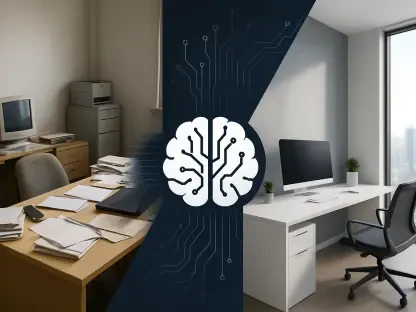Artificial intelligence (AI) sits at the forefront of technological innovation, driving a seismic shift in computing architectures and real-world applications. The discourse is largely influenced by Nvidia Corp. CEO Jensen Huang, who spoke extensively about this transformation during the 2025 GTC conference.
This article delves into the evolutionary path of AI, analyzing its future across cloud deployments, enterprise integration, and advancements in robotics. By leveraging novel forecasting methodologies, it provides a robust outlook on how AI is set to overhaul data center infrastructures and operational paradigms.
Transformative Shift in Computing
From Traditional to Real-Time Computing
The technological renaissance in AI and computing is marked by a migration from conventional data handling methodologies to an era that prioritizes real-time actions on data. This shift is driven by sophisticated silicon technology, groundbreaking infrastructures, and increased reliance on automation. Traditional computing models, which primarily focused on batch processing and human intervention, are gradually being replaced by systems capable of processing vast amounts of data instantaneously. This transition not only enhances efficiency but also opens new avenues for innovation in various sectors, ranging from healthcare to finance.
The impetus behind real-time computing is the urgent need for businesses to stay competitive in an increasingly data-driven world. With the development of cutting-edge processors and AI applications, organizations are now equipped to handle complex datasets more efficiently. This shift also correlates with the rise of edge computing and the proliferation of Internet of Things (IoT) devices, which collectively generate massive amounts of data. The seamless integration of these technologies into existing infrastructures is crucial for the continued evolution of real-time computing, enabling rapid decision-making and operational agility.
Market Volatility and IT Spending
Amidst economic uncertainties and geopolitical tensions, IT spending projections have become increasingly volatile. These fluctuations are further exacerbated by evolving regulatory landscapes that wield considerable influence over capital expenditures and strategic planning within the tech sector. Companies are now more cautious, balancing the imperative to invest in innovative technologies like AI against the backdrop of fluctuating market conditions. This environment underscores the need for adaptive strategies that can mitigate risks while capitalizing on emerging opportunities.
The unpredictable nature of IT spending is a critical factor for stakeholders in the technology industry. Firms are navigating through a labyrinth of budget constraints, prioritizing investments that offer the highest potential returns. While AI remains a focal point for many organizations, the ability to allocate resources effectively requires a nuanced understanding of market dynamics. The challenge lies in anticipating regulatory changes and economic shifts that could impact long-term investment decisions, making it essential for companies to stay agile and informed.
Sustained AI Investment
Economic Pressures Versus AI Prioritization
Despite broader economic pressures, investments in AI technologies continue to burgeon. Organizations are channeling resources into AI to stay ahead of competitors and enhance operational efficiency. This commitment to AI persists largely due to its transformational potential, offering innovative solutions that can redefine industry standards. Even in the face of potential hindrances posed by public policy, the strategic importance of AI is widely recognized, driving sustained investment in research and development.
The prioritization of AI in business strategies is indicative of its far-reaching impact. Companies are increasingly leveraging AI for process optimization, customer engagement, and predictive analytics. These applications not only improve existing operations but also create new avenues for growth and innovation. The ability to harness the power of AI effectively can determine an organization’s market positioning, making it a critical area of focus. As a result, the investment in AI technologies is viewed not just as a necessity but as a strategic imperative for long-term success.
Role of Hyperscalers
Crucial to the AI infrastructure narrative are hyperscalers like Amazon, Google, and Microsoft. These entities are spearheading the creation of scalable and efficient AI environments, acting as the bedrock for both consumer-facing and enterprise-level applications. Hyperscalers are uniquely positioned to leverage economies of scale, offering robust cloud platforms that facilitate the deployment and management of AI workloads. Their role is pivotal in accelerating the adoption of AI across various industries, providing the necessary infrastructure to support complex and data-intensive applications.
The influence of hyperscalers extends beyond mere infrastructure provision. They are actively involved in advancing AI research, contributing to the development of new algorithms and technologies. By fostering innovation and providing accessible platforms, hyperscalers enable organizations of all sizes to integrate AI into their operations. This democratization of AI technology is essential for driving widespread adoption and realizing the full potential of AI-driven solutions. As key enablers in the AI ecosystem, hyperscalers continue to shape the trajectory of AI development and deployment.
AI in Enterprise On-Premises
Gradual Adoption and Data Gravity
The journey to on-premises AI integration within enterprises is characterized by gradual but inevitable progress. The impetus behind this trend lies in data gravity and the necessity to assimilate with existing systems. Enterprises are recognizing the value of keeping data close to its source, minimizing latency and enhancing performance. This approach is particularly relevant for industries with stringent data privacy and security requirements. By leveraging hardware-centric offerings from vendors like Dell and HPE, enterprises are progressively laying the foundation for robust AI capabilities.
The concept of data gravity underscores the challenges and opportunities associated with on-premises AI integration. As data continues to grow in volume and complexity, the need for localized processing becomes more pronounced. Enterprises are investing in dedicated AI infrastructure to manage and analyze this data efficiently. This shift towards on-premises solutions is also driven by the desire to retain control over sensitive information and ensure compliance with regulatory standards. The gradual adoption of these technologies reflects a strategic approach to building sustainable and scalable AI capabilities.
Challenges and Long-Term Payoff
Despite challenges in system integration and data complexities, the long-term benefits of AI deployment within enterprise data centers are substantial. The commitment from major vendors to streamline these processes underscores the cumulative payoff on the horizon. Enterprises are navigating through a series of technical and operational obstacles, including the need for specialized skills and the complexities of integrating AI with legacy systems. However, the potential rewards in terms of enhanced efficiency, improved decision-making, and competitive advantage are driving sustained interest and investment in on-premises AI.
The journey toward effective AI integration involves overcoming numerous challenges, but the long-term payoff is substantial. Major vendors are introducing solutions designed to simplify deployment and integration processes, making AI more accessible to enterprises. These advancements are crucial for accelerating adoption and maximizing the benefits of AI technologies. As enterprises continue to invest in AI, they are laying the groundwork for a future where AI-driven insights and automation are integral to business operations. The strategic focus on overcoming initial hurdles is essential for realizing the full potential of AI in the enterprise sector.
Robotics: The Next Frontier
Single-Purpose Robots
In the realm of robotics, single-purpose robots hold significant promise in terms of operational efficiency and cost management. These robots are designed to perform specific tasks with high precision and consistency, making them ideal for applications in manufacturing, warehousing, and healthcare. Their immediate applicability presents a lucrative opportunity for automation within various industries, driving improvements in productivity and reducing operational costs. The adoption of single-purpose robots is poised to accelerate, driven by the tangible benefits they offer in enhancing efficiency and streamlining processes.
The appeal of single-purpose robots lies in their ability to perform repetitive tasks with greater accuracy and speed than human workers. This capability is particularly valuable in environments where precision and consistency are critical. Industries such as automotive manufacturing and logistics are increasingly turning to single-purpose robots to optimize operations and improve throughput. The scalability of these robotic solutions further enhances their attractiveness, enabling businesses to deploy them in various settings and achieve significant efficiency gains. As the demand for automation continues to rise, single-purpose robots are set to become a cornerstone of operational strategies.
Complex Humanoid Robots
Despite their potential, humanoid robots face a more challenging path to widespread adoption. The complexity involved in their integration into real-world scenarios demands an extended development timeline. Unlike single-purpose robots, humanoid robots are designed to perform a wide range of tasks, often mimicking human actions and interactions. This level of versatility requires sophisticated AI algorithms, advanced sensors, and robust hardware, which collectively contribute to the complexity and cost of development. As a result, the adoption curve for humanoid robots is expected to be longer, with significant technological and operational challenges to overcome.
The broader adoption of humanoid robots is influenced by several factors, including their potential to revolutionize industries and improve quality of life. From assisting in healthcare settings to providing companionship and support in consumer markets, the applications for humanoid robots are vast. However, the journey to realizing their full potential involves addressing technical hurdles and ensuring seamless integration into everyday environments. The development of more intuitive and adaptable AI systems, along with advancements in robotics technology, will play a crucial role in accelerating the adoption of humanoid robots. While the path is challenging, the long-term prospects for these versatile machines remain promising.
Accelerated Computing and Disaggregated Systems
Revolutionary Data Center Models
Accelerated computing, particularly Extreme Parallel Processing (EPP), is heralding a revolution in data center management. The paradigm shift towards GPU and AI-optimized architectures is anticipated to drive substantial increases in data center spending. Accelerated computing models are designed to handle complex workloads with greater efficiency, enabling faster processing and improved performance. This shift is critical for supporting the growing demand for AI applications, which require substantial computational power. As organizations continue to invest in AI, the role of accelerated computing in transforming data center operations becomes increasingly prominent.
The transition to GPU and AI-optimized architectures is reshaping the landscape of data center management. These advanced computing models offer significant performance enhancements, enabling organizations to process large datasets more efficiently. The adoption of accelerated computing is driven by the need to support complex AI workloads, which demand high levels of computational power and real-time processing capabilities. This evolution in data center design is expected to drive substantial increases in spending, as companies invest in the infrastructure needed to support AI-driven innovations. The integration of accelerated computing into data centers is a critical step towards realizing the full potential of AI technologies.
Emergence of Specialized Solutions
The industry’s migration towards specialized AI-optimized infrastructures highlights a preference for bespoke solutions rather than generic models. Sectors requiring strict compliance, such as finance and healthcare, exemplify this trend. These industries demand high levels of precision, security, and reliability, which can be achieved through tailored AI solutions. The move towards specialized infrastructure reflects a broader recognition of the unique requirements and challenges associated with different sectors. By leveraging customized AI-optimized architectures, organizations can achieve better alignment with their specific needs and enhance overall performance.
The emergence of specialized AI solutions indicates a growing preference for infrastructure designed to meet the unique demands of specific industries. This trend is particularly evident in sectors that require high levels of compliance and security. Customized AI-optimized architectures offer enhanced performance, reliability, and scalability, making them an attractive option for organizations operating in these environments. The shift towards specialized solutions underscores the importance of aligning technology with business needs, enabling companies to leverage AI more effectively. As the industry continues to evolve, the demand for bespoke AI infrastructures is expected to grow, driving further innovation and adoption.
The Uncertain Path of Edge Computing
Potential and Challenges
Edge AI computing offers an array of exciting possibilities, yet its adoption remains uncertain. Several factors, including varied requirements and constraints, contribute to this unpredictability. Edge computing brings computation and data storage closer to the source of data generation, reducing latency and enhancing processing speed. This capability is particularly valuable for applications that require real-time data analysis and decision-making. However, the adoption of edge AI computing is influenced by challenges such as integration complexity, security concerns, and the need for robust infrastructure. These factors collectively contribute to the uncertain trajectory of edge computing in the broader AI landscape.
The potential of edge AI computing lies in its ability to deliver real-time insights and enhance operational efficiency. By processing data closer to its source, edge computing can reduce latency and improve response times, making it ideal for applications in industries such as manufacturing, healthcare, and transportation. Despite its promise, the adoption curve for edge AI computing is steep, with numerous hurdles to overcome. The complexities of integrating edge solutions with existing systems, ensuring data security, and managing infrastructure costs are significant challenges that need to be addressed. As organizations navigate these obstacles, the potential for edge AI computing to revolutionize various sectors remains substantial.
Nvidia’s Role in Edge Computing
The article raises questions about Nvidia’s potential dominance within the edge computing segment, pointing to the unique challenges and opportunities that edge computing represents in the broader AI landscape. Nvidia’s advancements in GPU technology and its focus on AI-optimized architectures position it as a key player in this space. However, the adoption of edge computing is influenced by factors such as infrastructure compatibility, deployment costs, and the ability to address specific industry needs. Nvidia’s role in shaping the future of edge computing will depend on its ability to navigate these challenges and deliver solutions that meet the diverse requirements of different sectors.
Nvidia’s involvement in edge computing is indicative of its broader strategy to expand its footprint in the AI ecosystem. The company’s focus on developing advanced GPU technology and AI-optimized solutions positions it well to capitalize on the growing interest in edge computing. However, the success of Nvidia’s initiatives in this area will depend on its ability to address the unique challenges associated with edge deployments. This includes ensuring seamless integration with existing infrastructures, providing robust security measures, and offering cost-effective solutions that cater to the needs of different industries. As Nvidia continues to innovate and adapt, its role in the evolving landscape of edge computing will be closely watched.
Opportunities in Public Cloud AI
In its deliberate approach to addressing the complexities of cryptocurrencies, the SEC opted for another delay in its verdict on the spot Ethereum ETF. The extension grants the SEC an opportunity not only to conduct an in-depth examination of Ethereum’s suitability for ETF status but also to source public insight, which could heavily sway the conclusion. This speaks to the SEC’s attentiveness to the nuances of digital assets and their integration into regulatory frameworks, which it does not take lightly. The situation closely parallels the stalling faced by Grayscale, who is also waiting for the green light to transform its Ethereum Trust into a spot ETF, raising questions about the contrasting regulatory processes for Bitcoin and Ethereum.
Hyperscalers in the Spotlight
Hyperscaler environments are ideal for AI deployment due to their vast data and computational capabilities. Entities like OpenAI and Meta Platforms exemplify the focus on consumer data fueling AI innovation. These platforms leverage large-scale cloud infrastructure to support AI-driven applications, enabling organizations to process and analyze vast amounts of data efficiently. The scalability and flexibility offered by hyperscalers are crucial for driving advancements in AI, providing the necessary resources to develop and deploy innovative solutions. As AI continues to evolve, the role of hyperscalers in facilitating its adoption and growth becomes increasingly significant.
The emphasis on consumer-generated data highlights the importance of hyperscalers in the AI landscape. Platforms like OpenAI utilize the extensive computational power of hyperscaler environments to drive research and development in AI technologies. This approach enables continuous innovation and improvement of AI models, fostering the development of new applications that cater to various consumer needs. The strategic importance of hyperscalers in the AI ecosystem is further underscored by their ability to provide scalable and reliable infrastructure, making them indispensable for organizations looking to harness the power of AI for competitive advantage.
Forecasting AI Integration
The forecast indicates a continuation of AI integration in public cloud environments, underscoring the strategic importance of AI in maintaining competitive advantages. Hyperscalers are expected to play a central role in this evolution, providing the infrastructure and resources needed to support the growing demand for AI applications. The adoption of AI in public cloud environments is anticipated to accelerate, driven by the need for scalable, flexible, and cost-effective solutions. As organizations continue to explore the potential of AI, the strategic value of integrating AI into public cloud platforms will become increasingly evident.
The ongoing integration of AI into public cloud environments is a testament to the strategic importance of these technologies in modern business operations. Hyperscalers are at the forefront of this trend, offering robust platforms that enable organizations to leverage AI for innovation and growth. The ability to scale AI applications efficiently and cost-effectively is a key driver of this integration, making public cloud environments an attractive option for companies looking to enhance their AI capabilities. As the forecast suggests, the adoption of AI in public cloud environments is expected to continue its upward trajectory, highlighting the critical role of hyperscalers in the AI ecosystem.
Enterprise AI Forecasts
Future of On-Premises Deployments
The gradual enhancement of on-premises AI capabilities is expected to gather momentum post-2026. The forecast suggests that enterprise AI deployments will achieve critical mass around 2029, driven by the need for localized processing and data security. Enterprises are increasingly recognizing the benefits of integrating AI into their on-premises infrastructures, including improved performance, reduced latency, and enhanced control over sensitive data. This trend is expected to accelerate as organizations invest in the necessary hardware and software to support AI workloads, laying the groundwork for widespread adoption in the coming years.
The forecasted growth in on-premises AI deployments reflects the evolving priorities of enterprises. As data privacy concerns and regulatory requirements continue to influence strategic decisions, the ability to process and analyze data locally becomes increasingly important. On-premises AI solutions offer the flexibility and control needed to meet these demands, making them an attractive option for organizations in various sectors. The gradual buildup of AI capabilities within enterprise data centers is expected to culminate in significant adoption, driving innovation and operational efficiency. As enterprises continue to prioritize AI, the trajectory of on-premises deployments will become a key area of focus.
Strategic Vendor Support
Notable vendors are offering simplified deployment solutions, aiming to mitigate the complexities associated with on-premises AI integration and bolster adoption rates. Companies like Dell and HPE are developing hardware-centric solutions that streamline the process of integrating AI into enterprise data centers. These solutions are designed to address common challenges such as system compatibility, data management, and security, making it easier for organizations to deploy and manage AI workloads. The support from major vendors is instrumental in accelerating the adoption of on-premises AI, providing the tools and resources needed to overcome initial obstacles.
The role of strategic vendor support in the adoption of on-premises AI cannot be overstated. By offering solutions that simplify deployment and integration processes, vendors are helping enterprises navigate the complexities of AI implementation. These efforts are crucial for removing barriers to adoption, enabling organizations to leverage AI more effectively. The continued development of tailored solutions and dedicated support services will play a pivotal role in driving the growth of on-premises AI deployments. As vendors collaborate with enterprises to address specific needs and challenges, the adoption rates of on-premises AI are expected to increase, paving the way for widespread integration.
Robotics Market Predictions
Near-Term Single-Purpose Value
The immediate value proposition for single-purpose robots is clear, driven by their operational efficiency and cost benefits. These robots are designed to perform specific tasks with high precision and consistency, making them ideal for applications in manufacturing, warehousing, and healthcare. Their ability to streamline operations and reduce labor costs presents a compelling case for adoption. As industries increasingly seek automation solutions to enhance productivity, the demand for single-purpose robots is expected to rise, driving significant value in the near term.
The appeal of single-purpose robots lies in their ability to perform repetitive tasks with greater accuracy and speed than human workers. This capability is particularly valuable in environments where precision and consistency are critical. Industries such as automotive manufacturing and logistics are increasingly turning to single-purpose robots to optimize operations and improve throughput. The scalability of these robotic solutions further enhances their attractiveness, enabling businesses to deploy them in various settings and achieve significant efficiency gains. As the demand for automation continues to rise, single-purpose robots are set to become a cornerstone of operational strategies.
Long-Term Humanoid Potential
Artificial intelligence (AI) is revolutionizing technological innovation, driving significant changes in computing architectures and practical applications. This transformation is prominently discussed by Nvidia Corp. CEO Jensen Huang, who elaborated on the subject at length during the 2025 GTC conference.
The article explores the evolution of AI, focusing on its future in various domains such as cloud deployments, enterprise integration, and advances in robotics. By using innovative forecasting methods, the article presents a comprehensive outlook on how AI is poised to revamp data center infrastructures and operational models. The implications of AI’s growth are vast, promising increased efficiency and new capabilities across industries.
AI’s influence extends beyond just technological enhancements; it’s set to reshape business practices and operational workflows. As organizations integrate AI into their systems, they stand to benefit from heightened productivity and more intelligent data management. Robotics driven by AI is expected to achieve new levels of sophistication, impacting sectors from manufacturing to healthcare.
Overall, AI’s relentless progression signifies not just an upgrade in technology but a fundamental shift in how data and computing power are leveraged, heralding a future where smarter, more efficient systems become the norm.









